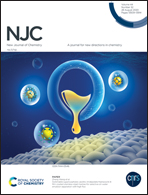Unravelling the strain-promoted [3+2] cycloaddition reactions of phenyl azide with cycloalkynes from the molecular electron density theory perspective†
Abstract
The strain-promoted [3+2] cycloaddition (SP-32CA) reactions of phenyl azide with a series of five strained cycloalkynes C5–C9 have been studied within molecular electron density theory (MEDT) at the MPWB1K/6-311G(d,p) computational level. These zwitterionic type SP-32CA reactions take place through a one-step mechanism, with activation enthalpies in acetonitrile between −4.2 and 19.9 kcal mol−1. An excellent linear correlation between the decrease in activation enthalpies and the ring size of this series of cycloalkynes can be established. The present study shows that the highly strained cycloalkynes C5 and C6 experience a different chemical reactivity than less strained cycloalkynes C7–C9, caused by the noticeable electrophilic character of the former ones. The present MEDT study permits establishing that the loss of the cycloalkyne strain along the reaction path together with easy depopulation of the C–C![[triple bond, length as m-dash]](https://www.rsc.org/images/entities/char_e002.gif) C–C bonding region along these SP-32CA reactions, and not “less distortion of the 1,3-dipole in the transition state geometry”, as has been suggested, is responsible for the kinetics and thermodynamics of these SP-32CA reactions.
C–C bonding region along these SP-32CA reactions, and not “less distortion of the 1,3-dipole in the transition state geometry”, as has been suggested, is responsible for the kinetics and thermodynamics of these SP-32CA reactions.
![Graphical abstract: Unravelling the strain-promoted [3+2] cycloaddition reactions of phenyl azide with cycloalkynes from the molecular electron density theory perspective](/en/Image/Get?imageInfo.ImageType=GA&imageInfo.ImageIdentifier.ManuscriptID=D0NJ02711A&imageInfo.ImageIdentifier.Year=2020)


 Please wait while we load your content...
Please wait while we load your content...